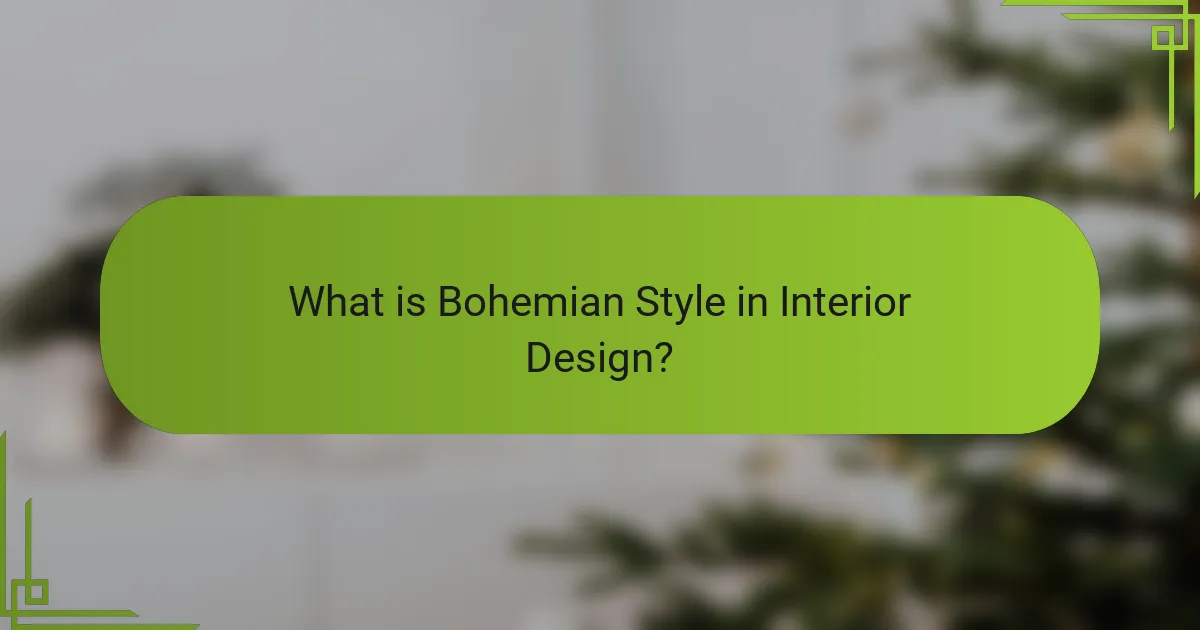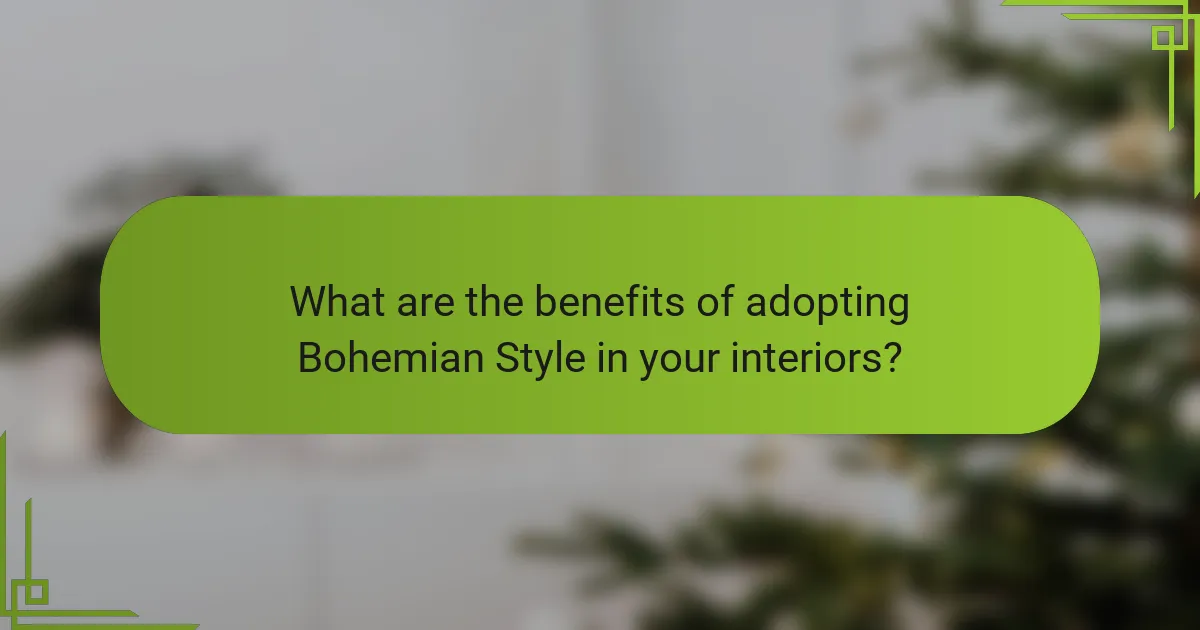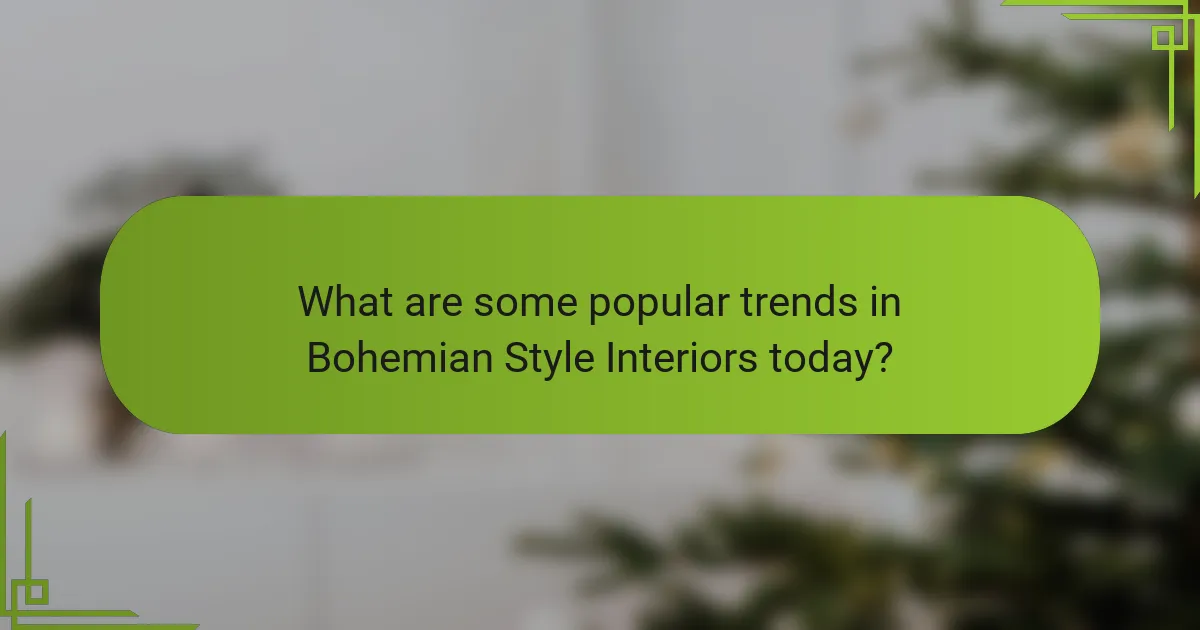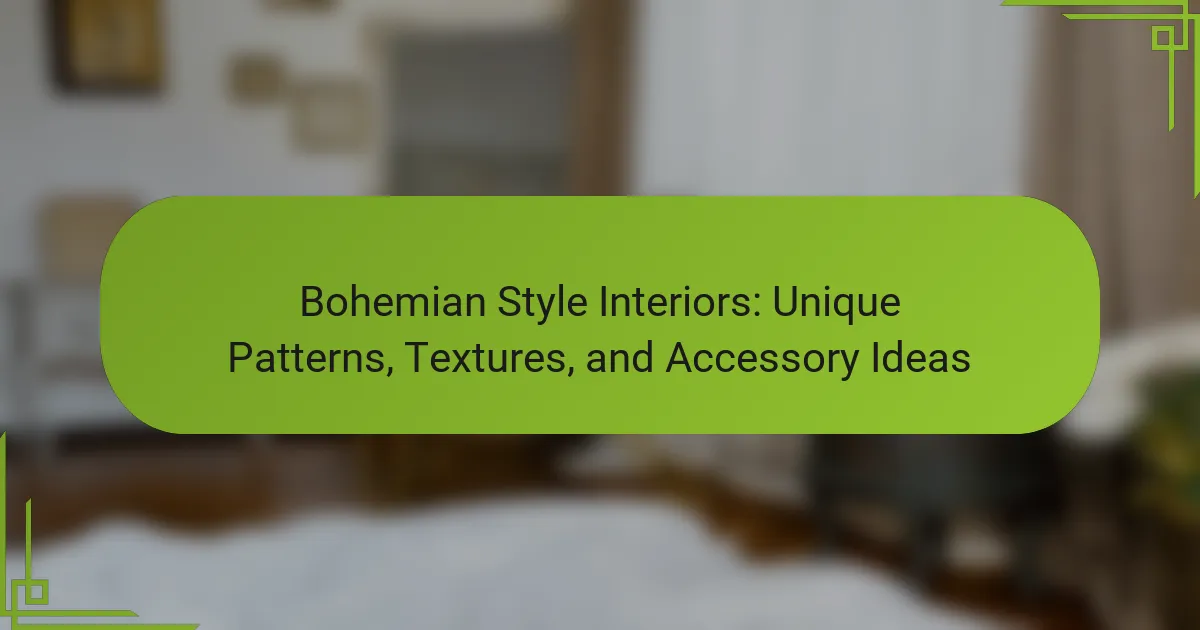
What is Bohemian Style in Interior Design?
Bohemian style in interior design is an eclectic and artistic approach characterized by vibrant colors, diverse patterns, and a mix of cultural influences. This style often incorporates vintage and handmade items, creating a cozy and personalized atmosphere. Key elements include layered textiles, such as rugs and cushions, along with an abundance of plants and natural materials. The aesthetic values individuality and self-expression, encouraging homeowners to showcase their unique tastes and travels. Bohemian interiors often feature a combination of modern and traditional elements, resulting in a harmonious yet unconventional space. This style’s roots can be traced back to the 19th-century bohemian lifestyle, which emphasized creativity and nonconformity.
How did Bohemian Style originate and evolve?
Bohemian Style originated in the early 19th century among artists and writers in France. It was influenced by the Romani people, who were often referred to as “Bohemians.” This style embraced a carefree lifestyle, prioritizing artistic expression over materialism. The aesthetic was characterized by eclectic decor, vibrant colors, and a mix of patterns. Over time, it evolved to incorporate elements from various cultures and eras. The 1960s and 1970s saw a resurgence of Bohemian Style, aligning with counterculture movements. Today, it continues to inspire interior design, emphasizing individuality and creativity.
What cultural influences shaped Bohemian Style?
Bohemian Style is shaped by various cultural influences, primarily from the Romani people, Eastern European traditions, and 1960s counterculture. The Romani culture introduced vibrant colors, eclectic patterns, and a free-spirited aesthetic. Eastern European folk art contributed intricate textiles and handcrafted decor elements. The 1960s counterculture movement emphasized individuality and self-expression, further popularizing Bohemian Style. This style embraces a mix of global influences, including Moroccan, Indian, and Mexican designs. Each cultural element adds unique textures and layers to the overall aesthetic. The combination of these influences creates a rich, diverse interior style that is both artistic and personal.
How has Bohemian Style changed over the decades?
Bohemian Style has evolved significantly over the decades. In the 1960s, it embraced vibrant colors, eclectic patterns, and a carefree attitude. This period was marked by influences from the counterculture movement. The 1970s saw a rise in earthy tones and natural materials, reflecting a back-to-nature ethos. In the 1980s, the style incorporated more bold prints and layered textiles, showcasing maximalism. The 1990s shifted towards a more subdued palette, with a focus on vintage and thrifted items. In the 2000s, Bohemian Style became mainstream, merging with modern design elements. Today, it blends with minimalism while retaining its signature eclectic charm. This evolution reflects cultural shifts and changing aesthetic preferences over time.
What are the key characteristics of Bohemian Style Interiors?
Bohemian style interiors are characterized by a mix of colors, patterns, and textures. This design embraces an eclectic aesthetic, often featuring vibrant hues alongside neutral tones. Layering is a key aspect, with textiles such as rugs, cushions, and throws piled together. Natural materials like wood, rattan, and plants are commonly used to enhance the organic feel. Artwork and decorative items from various cultures are incorporated, creating a global influence. Furniture is often vintage or artisanal, adding uniqueness to the space. Personalization is essential, as bohemian interiors reflect individual tastes and experiences. Overall, this style promotes a relaxed, carefree atmosphere.
What unique patterns are commonly found in Bohemian interiors?
Unique patterns commonly found in Bohemian interiors include intricate geometric designs, floral motifs, and ethnic prints. These patterns often reflect a mix of cultural influences, showcasing diversity. Geometric designs can be seen in textiles and wall art, providing a modern touch. Floral motifs add a natural element, often represented in cushions and curtains. Ethnic prints, inspired by global cultures, are frequently found in rugs and throws. Layering these patterns creates a visually rich environment. The combination of these unique patterns contributes to the eclectic and relaxed vibe characteristic of Bohemian style.
How do textures play a role in defining Bohemian spaces?
Textures are essential in defining Bohemian spaces. They create a layered, eclectic aesthetic that characterizes this style. Various materials like woven fabrics, natural fibers, and distressed surfaces contribute to the overall vibe. Textiles such as rugs, cushions, and throws add warmth and comfort. The use of diverse textures encourages visual interest and depth. For example, macramé wall hangings and embroidered pillows showcase craftsmanship. Additionally, mixing smooth and rough textures enhances the organic feel of the space. This approach reflects the Bohemian ethos of individuality and artistic expression.
What accessories enhance Bohemian Style Interiors?
Accessories that enhance Bohemian style interiors include vibrant textiles, eclectic wall art, and natural elements. Textiles such as patterned throw pillows and woven blankets add color and comfort. Eclectic wall art, including tapestries and framed prints, creates visual interest. Natural elements like plants and macramé hangers introduce organic textures. Decorative items such as lanterns and vintage finds contribute to a curated look. Layering rugs with different patterns enhances the cozy atmosphere. Unique accessories reflect personal style and travel experiences. These elements collectively embody the free-spirited essence of Bohemian design.
Which types of textiles are essential for a Bohemian look?
Essential textiles for a Bohemian look include cotton, linen, and silk. These fabrics are known for their natural textures and vibrant patterns. Cotton is breathable and versatile, making it ideal for drapes and cushions. Linen offers a relaxed, casual feel, perfect for tablecloths and upholstery. Silk adds a touch of luxury and can be used in throws and decorative pillows. Additionally, tapestry and macramé are popular for wall hangings and decorative accents. These textiles contribute to the eclectic and layered aesthetic characteristic of Bohemian style.
How can artwork and decorative items contribute to the Bohemian aesthetic?
Artwork and decorative items enhance the Bohemian aesthetic by adding color, texture, and personal expression. These elements reflect the free-spirited nature of Bohemian style. Vibrant paintings and eclectic wall hangings create visual interest. Textiles, such as tapestries and cushions, introduce warmth and comfort. Unique artifacts from various cultures contribute to a global, worldly feel. Layering these items fosters a cozy, lived-in atmosphere. The combination of different styles and periods is essential for authenticity. Overall, artwork and decorative items are crucial for embodying the Bohemian spirit.
How can you incorporate Bohemian Style into your home?
To incorporate Bohemian style into your home, use a mix of colors, patterns, and textures. Layer textiles like rugs, throws, and cushions to create depth. Utilize vibrant wall art and eclectic decor to showcase individuality. Include plants for a natural, lively atmosphere. Opt for vintage or handmade furniture to enhance uniqueness. Incorporate global elements, such as Moroccan lamps or Indian tapestries, for authenticity. Curate personal collections of items that reflect your travels or interests. This approach aligns with the Bohemian ethos of self-expression and creativity.
What are some practical tips for mixing patterns effectively?
Mixing patterns effectively involves balancing different designs to create a cohesive look. Start with a neutral base to anchor the patterns. Choose a variety of patterns with different scales, such as large florals with small geometrics. Limit the color palette to three or four complementary colors to maintain harmony. Incorporate solid colors to break up busy patterns and provide visual rest. Use varying textures to add depth and interest to the mix. Layer patterns in different areas of the space to create a dynamic flow. Finally, trust your instincts; if it feels right, it likely is.
How can you layer textures to create depth in a Bohemian space?
Layering textures in a Bohemian space involves combining various materials and fabrics. Use rugs of different weaves and patterns to add visual interest. Incorporate throw pillows with diverse textures like velvet, cotton, and macramé. Mix lightweight curtains with heavier drapes for contrast. Add woven baskets and natural elements like wood or stone for organic depth. Layering these elements creates a cozy, inviting atmosphere. The eclectic nature of Bohemian design encourages experimentation with textures, enhancing the overall aesthetic.

What are the benefits of adopting Bohemian Style in your interiors?
Adopting Bohemian Style in your interiors promotes creativity and individuality. This style encourages personal expression through diverse patterns and textures. It often features vibrant colors and eclectic decor, making spaces visually stimulating. The use of natural materials and handmade items fosters a connection to nature. Bohemian interiors can create a cozy and inviting atmosphere. This style also allows for flexibility in design, enabling easy updates and changes. Research indicates that personalized spaces can enhance well-being and reduce stress. Overall, Bohemian Style contributes to a unique and dynamic living environment.
How does Bohemian Style promote individuality and creativity?
Bohemian Style promotes individuality and creativity by encouraging personal expression through diverse design elements. This style embraces a mix of colors, patterns, and textures that reflect personal tastes. Each Bohemian space is unique, as it often incorporates vintage and handmade items. The use of eclectic decor allows individuals to showcase their personality and experiences. Bohemian Style often features cultural artifacts, which add to its distinctive character. This approach fosters creativity by inviting experimentation with different styles and arrangements. The freedom to combine various influences empowers individuals to create spaces that resonate with their identity. Overall, Bohemian Style serves as a canvas for self-expression and artistic exploration.
In what ways can Bohemian decor foster a sense of comfort and warmth?
Bohemian decor fosters a sense of comfort and warmth through its use of vibrant colors and diverse textures. The incorporation of rich textiles, such as tapestries and layered rugs, creates a cozy atmosphere. Eclectic furniture arrangements promote a relaxed and inviting space. Natural elements, like plants and wooden accents, enhance a feeling of connection to nature. Personal artifacts and handmade items add a unique touch, making the space feel lived-in. The use of soft lighting, such as fairy lights or lanterns, contributes to a warm ambiance. Overall, Bohemian decor emphasizes individuality and comfort, inviting people to feel at home.
What challenges might you face when designing in Bohemian Style?
Designing in Bohemian Style presents several challenges. One challenge is achieving cohesive aesthetics amidst eclectic elements. The style encourages mixing patterns, colors, and textures, which can lead to visual chaos. Another challenge is selecting the right balance of furnishings. Overcrowding a space with too many items can make it feel cluttered. Additionally, sourcing authentic Bohemian decor can be difficult. Many items are unique or handmade, making them harder to find. Maintaining functionality while embracing a free-spirited design can also pose issues. Spaces must remain livable despite a layered look. Finally, understanding the cultural significance of certain elements is crucial. Misrepresenting or appropriating cultural symbols can lead to insensitivity.
How can you avoid a cluttered look in a Bohemian interior?
To avoid a cluttered look in a Bohemian interior, prioritize a few statement pieces. Select larger furniture that serves as focal points. Use a cohesive color palette to unify the space. Incorporate negative space by leaving areas free of decor. Limit the number of accessories displayed at once. Rotate decorative items periodically to refresh the look without overcrowding. Ensure that textiles and patterns complement rather than compete with each other. This method maintains the eclectic charm while preventing visual chaos.
What are the best practices for maintaining balance in a Bohemian space?
To maintain balance in a Bohemian space, incorporate a mix of textures and patterns while ensuring harmony. Use textiles such as woven rugs, macramé hangings, and layered fabrics. Balance bold colors with neutral tones to prevent overwhelming the space. Group decor items in odd numbers for visual interest and balance. Incorporate plants for natural elements, which bring freshness and life. Use furniture that complements rather than competes with the decor. Ensure there is open space to allow for movement and flow. Finally, personal touches, like art and travel souvenirs, create a cohesive and inviting atmosphere.

What are some popular trends in Bohemian Style Interiors today?
Popular trends in Bohemian Style Interiors today include the use of vibrant colors and eclectic patterns. Layering textiles such as rugs, throws, and pillows adds warmth and character. Natural materials like wood and rattan are favored for furniture and decor. Indoor plants are commonly used to bring life and freshness to spaces. Vintage and handmade items are increasingly sought after for their unique charm. Open spaces with a relaxed layout promote a sense of freedom and creativity. Art and personal collections are prominently displayed to reflect individual style. These trends emphasize comfort, creativity, and a connection to nature.
How is sustainable design being integrated into Bohemian interiors?
Sustainable design is integrated into Bohemian interiors through the use of eco-friendly materials and practices. Designers often choose reclaimed wood for furniture and decor. This reduces waste and adds character to spaces. Natural textiles like organic cotton and linen are preferred for upholstery and curtains. These materials are biodegradable and free from harmful chemicals. Additionally, plants are commonly used in Bohemian design, enhancing air quality and promoting sustainability. Upcycled and vintage items are frequently incorporated, giving unique charm while minimizing environmental impact. This fusion of sustainability with Bohemian aesthetics creates a harmonious and responsible living space.
What role do plants and natural elements play in modern Bohemian design?
Plants and natural elements are central to modern Bohemian design. They enhance the aesthetic by introducing organic textures and colors. Incorporating greenery creates a vibrant and lively atmosphere. Natural elements like wood and stone add warmth and authenticity. These features promote a connection to nature, which is essential in Bohemian style. Research shows that biophilic design, which includes plants, can improve well-being and reduce stress. This aligns with the Bohemian ethos of comfort and individuality. Therefore, plants and natural elements are not just decorative; they are integral to the philosophy of modern Bohemian design.
What are the latest accessory ideas for enhancing Bohemian interiors?
Latest accessory ideas for enhancing Bohemian interiors include vibrant textiles, eclectic wall art, and natural elements. Textiles such as patterned throw pillows and woven blankets add warmth and color. Eclectic wall art can consist of macramé hangings or framed prints that reflect personal style. Natural elements like potted plants and wooden accents bring an organic feel. Layered rugs with different textures create visual interest. Unique lighting fixtures, such as lanterns or string lights, enhance ambiance. These accessories contribute to a cozy and inviting atmosphere characteristic of Bohemian design.
How can you creatively use vintage finds in Bohemian decor?
Incorporating vintage finds in Bohemian decor enhances the eclectic aesthetic. Vintage furniture can serve as statement pieces, adding character and history. Items like ornate mirrors create focal points while reflecting light. Vintage textiles, such as quilts or tapestries, introduce rich patterns and textures. Mixing these textiles with modern elements creates visual interest. Vintage accessories, like globes or books, can add layers to the decor. Displaying collections of vintage items adds a personalized touch. Using vintage finds supports sustainability by reusing materials.
What are the must-have items for a contemporary Bohemian look?
Must-have items for a contemporary Bohemian look include flowy maxi dresses, oversized cardigans, and layered jewelry. These garments often feature vibrant colors and intricate patterns. Accessories like wide-brimmed hats and fringe bags enhance the style. Textiles such as patterned throws and eclectic rugs contribute to the aesthetic. Natural elements like plants add freshness to the space. Vintage furniture pieces create a unique vibe. Overall, the contemporary Bohemian look emphasizes comfort and artistic expression.
What practical tips can help you achieve a successful Bohemian interior?
To achieve a successful Bohemian interior, incorporate a mix of colors, patterns, and textures. Use vibrant textiles like rugs, cushions, and throws. Layering these elements creates depth and warmth. Include a variety of plants for a natural touch. Incorporate vintage or handmade furniture to add character. Use artwork and decorative items from different cultures. This eclectic approach reflects the Bohemian spirit. Arrange items in a way that feels casual and inviting. Personalize the space with meaningful objects to enhance its uniqueness.
How can you effectively source materials and accessories for your Bohemian space?
To effectively source materials and accessories for your Bohemian space, explore local thrift shops and flea markets. These venues often offer unique, one-of-a-kind items that fit the eclectic Bohemian aesthetic. Additionally, consider online marketplaces like Etsy or eBay, where artisans sell handmade or vintage goods. These platforms provide a wide variety of options to enhance your space.
Visit local artisan markets for textiles, pottery, and wall hangings. Supporting local artisans not only enriches your decor but also promotes community craftsmanship. Incorporate natural materials like wood, rattan, and cotton to align with the Bohemian style’s emphasis on organic elements.
Research shows that incorporating diverse textures and colors creates a vibrant atmosphere. A study by the Journal of Interior Design highlights how layering different materials can enhance visual interest in a space. By curating items that reflect your personal style, you can create a cohesive and inviting Bohemian environment.
What common mistakes should you avoid when decorating in Bohemian style?
Common mistakes to avoid when decorating in Bohemian style include overcrowding the space. This style thrives on a relaxed, eclectic aesthetic. Too many items can create chaos instead of harmony. Another mistake is ignoring color balance. Bohemian decor often features vibrant hues, but too much can overwhelm. Aim for a cohesive palette with pops of color.
Failing to incorporate various textures is also a common error. Textures add depth and interest to the design. Use a mix of fabrics, materials, and finishes to enhance the Bohemian vibe. Additionally, neglecting personal touches can detract from authenticity. Bohemian style is deeply personal and should reflect individual tastes.
Lastly, avoiding symmetry can lead to an unbalanced look. While asymmetry is embraced, some balance is essential for visual appeal. These mistakes can hinder the true essence of Bohemian decor.
Bohemian Style Interiors focus on an eclectic aesthetic characterized by unique patterns, vibrant colors, and diverse textures. The article explores the origins and evolution of Bohemian design, highlighting key elements such as layered textiles, vintage furnishings, and cultural influences. It discusses how to effectively incorporate accessories, plants, and sustainable materials while avoiding common design mistakes. Additionally, practical tips for achieving a cohesive Bohemian look and the impact of personal expression in interior spaces are provided, making it a comprehensive guide for anyone interested in this distinctive style.
